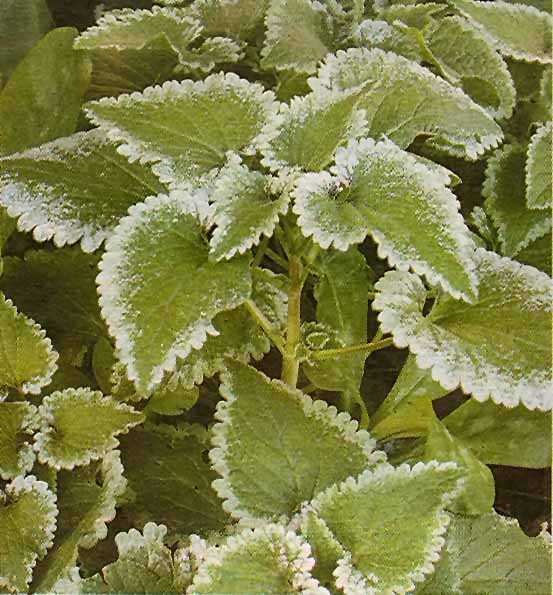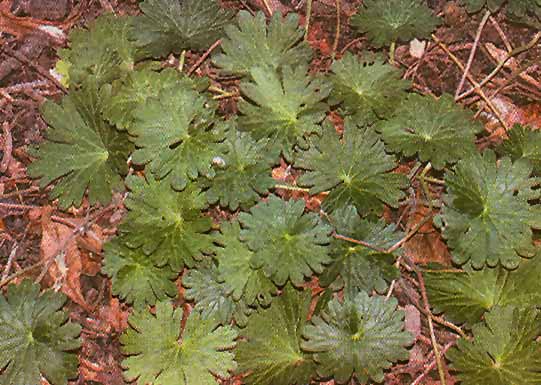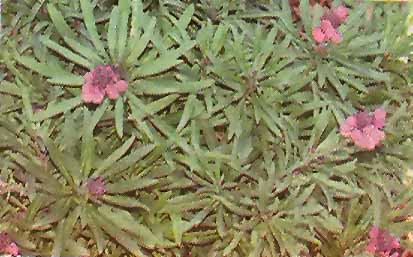 |
||
|
A Living Carpet
Perennials and annuals are useful for preventing winter weed growth and regulating the microclimate of the soil, as well as creating a delightful green tapestry over the bare earth of winter By Jennifer Gay Athens News |
||
|
Whenever I set about creating groundcover, I often tend to think first of using the toughest plants, those that will endure the worst possible scenarios such as hot, exposed slopes, or dark, dry shade. They are especially useful where low maintenance is required, after all, One of the main reasons for covering the ground with a dense carpet of plants is to minimise weeding among ornamental plants. Groundcover also successfully reduces evaporation from exposed soils; a dense planting of drought-resistant plants such as Rock Rose (Cistus), Rosemary or Oleander will shade the soil and keep it Cool. Or, steep banks might be planted with spreading Juniper (Juniperus squamata 'Blue Carpet' is a good one), the succulent Aptenia cordifolia, or ever-reliable ivies; all-have a low spreading habit, evergreen foliage and vigorous rooted layers which combine to form a stable layer that prevents erosion of topsoil and prevents nutrient leaching. |
 The silver-trimmed leaves of Deadnettle make an attractive groundcover |
|
|
|
||
|
Perennials and annuals are just as useful for preventing winter weed growth and also play their role in regulating the microclimate of the soil. Filling every available patch of bare soil with their atttactive foliage, they create a delightful green tapestry. Many a groundcover perennials prefer shady position as their natural habitat is the understorey of woodlands, and they are therefore perfect for planning among roses, or young trees and shrubs which have yet to reach their full potential. While you wait for these plants to bulk out, the ground can be covered with early flowering perennials or annuals such as Violets, Irises, and Honeywort (Cerinthe retorta). |
 A green tapestry of Geranium |
|
|
Try. Deadnettle (Lamium moschatum) with its silver-trimmed leaves, Spotted Deadnettle (Lamium maculatum), or Yellow Archangel (Lamium galeobdolon 'Variegatum'). They seed themselves everywhere but are effective performers under the shade of large trees and look very pretty on a sunny winter's day. Honeywort is a joy, and though on the verge of invasive, I virtually never mind. With pretty white mottled leaves, Violet Honeywort (Cerinthe retorta) has narrow, tubular flowers, dark purple-brown filding to yellow cream, with purple bracts, while Honeywort (Cerinthe major) has very striking flowers, distinctively half yellow and half chocolate brown. Comfrey (Symphytum ibericum), well known for its healing properties, grows in the wild with Siberian Bugloss (Brunnera macrophylla), making impenetrable weed cover under shrubs. It forms carpeting mounds of creeping, dark green, rough leaves, the shoots surface rooting as they grow in spring before the new leaves are fully developed. Useful among large shrubs, in early spring small cream bells appear as an added bonus. Some groundcovers are better weed suppressants than others; the most valuable establish themselves quickly, have dense foliage that blocks out light to prevent weed germination, and retain their leaves during the summer season. Elephant's Ears (Bergenia cordifolia), is one such; spreading slowly by means of woody rhizomes, they make clumps of large, leathery, rounded, glossy leaves and markedly crinkled edges. The large sh.owy flower heads are soft pink. Again they tolerate drought well if given enough humus, but they don't like to be in really deep shade. Bergenia 'Purpurea' flowers in early spring and sends up huge, heavy heads of magenta supported on rhubarb-like -stalks. The beautiful leaves provide much needed contrast among smaller-leaved plants, and while at the end of the summer; their leaves look bedraggled by the ravages of the sun, they quickly refurnish after rain. Some of the true geraniums, notably cultivars, of Geranium macrorrhizum (flowering over a long period), have scented foliage and provide autumn colour. From southern Europe, it will make weed-proof groundcover in fair conditions, ie with shelter and good soil, and in such a situation, it is easily divided and rooted. Left to its own devices, it creeps about on its rooting stems, covered with small, lobed or deeply cut leaves. Foam Flower (Tiarella cofaifolia) and Epimedium x versicolor are both sturdy groundcover plants renowned for their drought tolerance in northern Europe, but may not stand up to conditions here. I would like to try them in a shady place with a soil rich in leaf mould, to see how they do. I suspect they won't be too happy with alkaline soils, but in woodland areas or in some mountainous areas inland, they might be worth a shot. In summer, Tiarella will almost certainly wither away, especially if exposed. Highly reliable as a native of Greek mountains, Narrow-leaved glaucous Spurge (Euphorbia rigida), a clump forming species bearing low, spreading stems, and its close relative, Euphorbia myrsinites very quickly and extensively cover surrounding soil. Lilyturf (Liriape muscan), a shade loving plant from China and Japan, grows well in well-drained soil, especially useful for dry shade. They like their site to be well prepared and take a little time to settle down but when established make low robust clumps of dark evergreen strap-shaped leaves and bear spikes of small, bell-shaped, mauve-pink flowers in autumn. Two other foliage plants I must mention which are highly suitable for the Mediterninean garden are: Catmint (Nepeta x faassenil), a valued plant for edgings, with flower spikes of pale lavender; and Lamb's Ears (Starchy byzantina and Stachys "olympica). Growing naturally from the Caucasus to Iran, both species do well in light soil and light shade, but in summer they need water to maintain their appearance. |
||
|
FLOWERING NOW Virgin's Bower
|
|
|
HCS readers can view other excellent articles by Jennifer Gay in the News & Issues and especially the sections of our extensive, permanent archives at the URL http://www.helleniccomserve.com./contents.html
All articles of Athens News appearing on HCS have been reprinted with permission. |
||
|
||
|
|
||
|
2000 © Hellenic Communication Service, L.L.C. All Rights Reserved. http://www.HellenicComServe.com |
||


